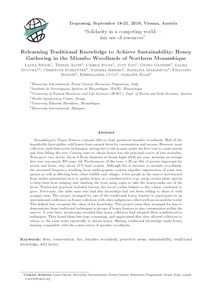Resource information
Mozambique's Niassa Reserve contains Africa's best preserved miombo woodlands. Half of the households there gather wild honey from natural hives for consumption and income. However, most collectors used destructive techniques: setting fire to the grasses under the hive tree to create smoke and then felling the tree. Cutting trees to obtain honey was the principal source of tree mortality. Trees grow very slowly, about 0.25 cm diameter at breast hight [dbh] per year, meaning an average hive tree was nearly 200 years old. Furthermore, of the trees > 20 cm dbh of species important for nectar and hives, only about 15% had cavities. Although fire is intrinsic to miombo woodlands, the increased frequency resulting from anthropogenic sources impedes regeneration of some tree species as well as affecting bees, other wildlife and villages. A few people in the reserve had learned from earlier generations how to gather honey in a nondestructive way, using certain plant species to keep bees from stinging and climbing the trees using ropes to take the honeycombs out of the hives. Traditional practices included leaving the larval combs behind so the colony continued to grow. Previously, the older men who had this knowledge had not been willing to share it with younger men. The project arranged for one of the traditional honey hunters to participate in an international conference on honey collection with other indigenous collectors from around the world. This helped him recognise the value of his knowledge. The project team then arranged for him to demonstrate these traditional techniques to groups of honey hunters in nine communities within the reserve. A year later, monitoring revealed that many collectors had adopted these nondestructive techniques. They found them less time consuming, and appreciated that they allowed collectors to return to the same trees repeatedly to obtain honey. Sharing traditional knowledge made honey hunting compatible with the conservation of miombo woodlands.


